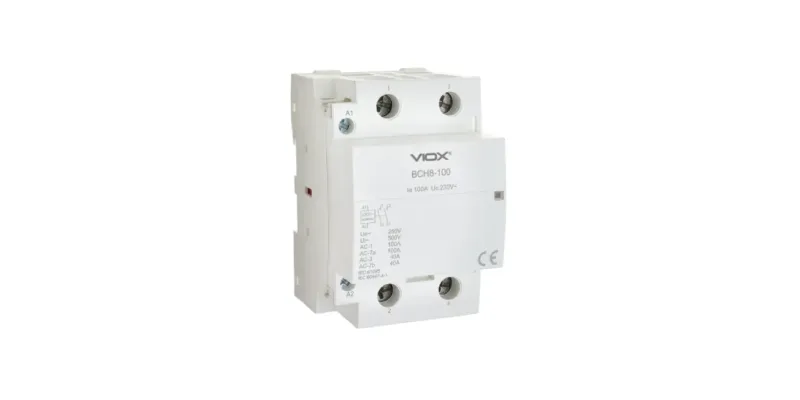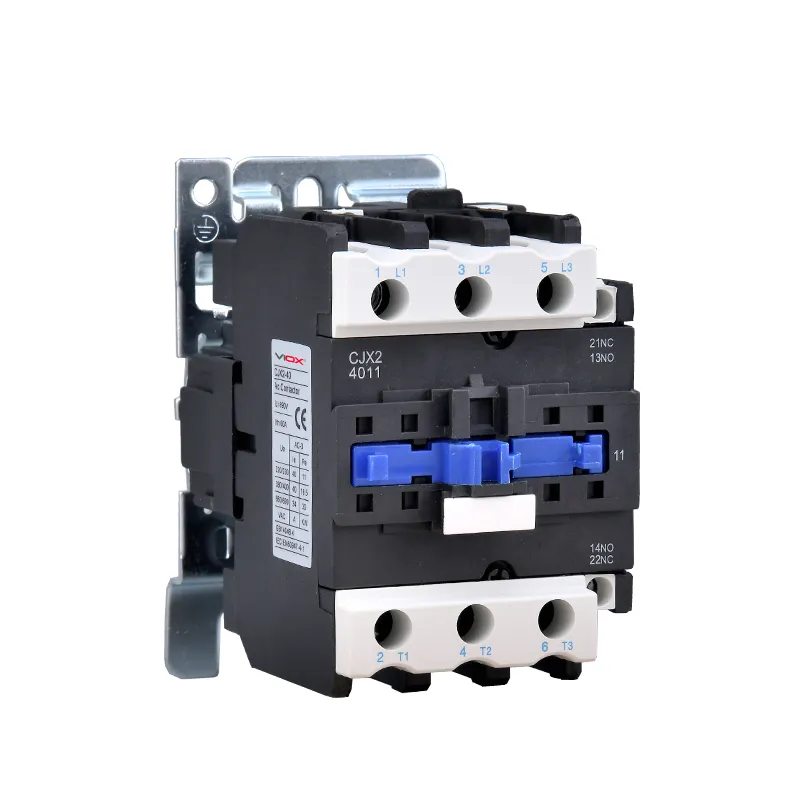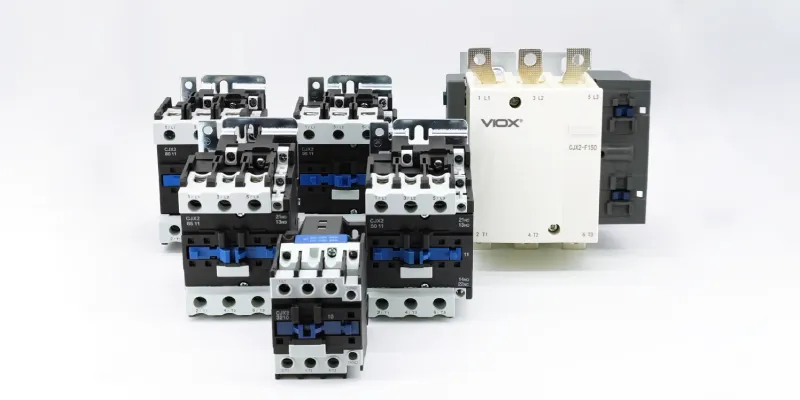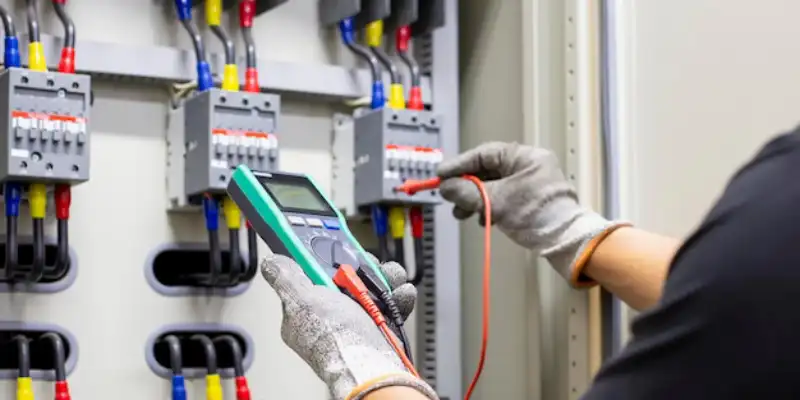Mabilis na Sagot: The main difference between a modular contactor and a traditional contactor (normal contactor) is their mounting and configuration design. Modular contactors are designed for DIN riles mounting in electrical panels with standardized modular widths, while traditional (normal) contactors typically use screw-mounting or panel-mounting configurations. Modular contactors offer space-efficient installation, easier maintenance, and standardized sizing, making them ideal for modern electrical panel designs.
Ano ang isang Modular Contactor?
A modular contactor is a compact electromagnetic switching device designed specifically for DIN rail mounting systems. These contactors feature standardized modular widths (typically measured in 17.5mm increments) and are engineered to fit seamlessly into modern electrical distribution panels alongside other modular devices like circuit breakers and relays.
Key Characteristics of Modular Contactors:
- DIN rail mounting system for tool-free installation
- Standardized modular widths (1, 2, 3, or 4 modules wide)
- Compact vertical design optimizing panel space
- Front-accessible terminals for easy wiring and maintenance
- Integrated auxiliary contacts in most models
What Is a Traditional Contactor (Normal Contactor)?
A traditional contactor (also called a normal or conventional contactor) is a traditional electromagnetic switching device that uses screw-mounting or panel-mounting configurations. These contactors have been the industry standard for decades and are designed for direct mounting to electrical panels, motor control centers, or mounting plates.
Key Characteristics of Traditional Contactors (Normal Contactors):
- Screw or bolt mounting to panels or mounting plates
- Larger physical footprint with horizontal orientation
- Traditional terminal block design with screw terminals
- Separate auxiliary contact blocks (often optional)
- Higher current ratings available (up to 1000A+)
Comprehensive Comparison: Modular vs Traditional Contactors (Normal Contactors)
| Tampok | Modular Contactor | Traditional Contactor (Normal Contactor) |
|---|---|---|
| Paraan ng Pag-mount | DIN rail clip-on | Screw/bolt mounting |
| Panel Space | Compact (17.5-70mm width) | Larger footprint (varies) |
| Oras ng Pag-install | 30-60 segundo | 5-15 minutes |
| Kasalukuyang Rating | 5-125A typical | 5-1000A+ available |
| Saklaw ng Boltahe | 24V-690V AC/DC | 24V-1000V AC/DC |
| Mga Pantulong na Contact | Usually integrated | Often separate add-on |
| Wire Management | Organized, compact | Traditional wire runs |
| Access sa Pagpapanatili | Front-accessible | May require panel removal |
| Cost per Unit | Moderate to high | Low to moderate |
| Standardisasyon | High (IEC standards) | Variable by manufacturer |
Mga application at Gumamit ng Kaso
When to Use Modular Contactors
Mga Ideal na Application:
- Pagbuo ng mga sistema ng automation requiring frequent panel access
- Motor control panels with space constraints
- Mga sistema ng kontrol sa pag-iilaw sa komersyal na mga gusali
- Mga control panel ng HVAC with multiple switching requirements
- Machine control cabinets requiring standardized components
Mga Espesyal na Kaso ng Paggamit:
- Pump control stations with limited panel space
- LED lighting contactors in electrical rooms
- Conveyor motor controls in manufacturing
- Air handling unit controls in commercial buildings
When to Use Traditional Contactors (Normal Contactors)
Mga Ideal na Application:
- Heavy industrial motor control requiring high current ratings
- Legacy system replacements maintaining existing configurations
- Mga proyektong sensitibo sa gastos where space isn’t constrained
- High-power applications above 125A ratings
- Mga pag-install sa labas requiring robust enclosures
Mga Espesyal na Kaso ng Paggamit:
- Large motor starters (50HP and above)
- Industrial furnace controls
- Heavy machinery contactors
- Mining equipment controls
⚠️ Safety Considerations
Critical Safety Requirements:
- Always de-energize circuits before installation or maintenance
- Verify proper current ratings for your specific application
- Follow NEC/IEC installation codes for contactor selection
- Use appropriate arc fault protection based on contactor type
- Tiyakin ang tamang bentilasyon around contactors to prevent overheating
Professional Installation Notes:
- Modular contactors require proper DIN rail installation with secure clipping
- Normal contactors need adequate mounting torque specifications
- Both types require proper wire sizing according to electrical codes
- Auxiliary contact wiring must match control voltage requirements
Selection Criteria: How to Choose the Right Contactor
Step 1: Determine Your Current Requirements
Calculate your load current:
- Motor loads: Use motor nameplate current × 125%
- Resistive loads: Use actual load current
- Lighting loads: Consider inrush current characteristics
Step 2: Evaluate Space Constraints
Panel space assessment:
- Choose modular if panel space is limited (less than 4″ width available)
- Choose normal if you have ample panel space and need higher ratings
- Isaalang-alang ang mga pangangailangan sa pagpapalawak sa hinaharap
Step 3: Consider Installation Requirements
Installation factors:
- Modular advantage: Tool-free installation, organized appearance
- Normal advantage: Familiar installation for most technicians
- Maintenance accessibility requirements
Step 4: Budget Analysis
Cost considerations:
- Initial cost: Normal contactors typically less expensive
- Installation cost: Modular contactors reduce labor time
- Long-term value: Consider maintenance and upgrade costs
🔧 Expert Installation Tips
For Modular Contactors:
- Verify DIN rail compatibility (35mm standard rail)
- Leave expansion space of at least one module width
- Use wire markers for organized identification
- Install from left to right following control logic sequence
- Check clip engagement by gentle pulling after installation
For Traditional Contactors (Normal Contactors):
- Use manufacturer-specified mounting torque values
- Maintain minimum clearances ayon sa mga kinakailangan ng NEC
- Install vibration dampeners in mobile applications
- Use proper wire management to prevent interference
- Label all terminals according to electrical drawings
Pag-Troubleshoot-Karaniwang Mga Isyu
Modular Contactor Problems:
- Poor DIN rail connection: Check rail cleanliness and clip engagement
- sobrang init: Verify adequate ventilation and current ratings
- Control voltage issues: Confirm auxiliary contact ratings match control circuit
Traditional Contactor (Normal Contactor) Problems:
- Mounting vibration: Check mounting bolt torque and use dampeners
- Contact wear: Monitor arc suppression and load characteristics
- Coil failure: Verify proper control voltage and frequency
Quick Reference Selection Guide
Choose Modular Contactors When:
- ✅ Panel space is limited
- ✅ Standardized installation preferred
- ✅ Frequent maintenance access needed
- ✅ Current requirements under 125A
- ✅ Modern panel design standards required
Choose Traditional Contactors (Normal Contactors) When:
- ✅ High current ratings needed (>125A)
- ✅ Cost is primary consideration
- ✅ Traditional mounting preferred
- ✅ Legacy system compatibility required
- ✅ Extreme environmental conditions present
Madalas Na Tinatanong Na Mga Katanungan
What is the main advantage of modular contactors over traditional contactors (normal contactors)?
Modular contactors offer space-efficient installation at standardized mounting that reduces installation time by up to 80% compared to traditional screw-mounted contactors. They also provide better organization in electrical panels.
Can I replace a normal contactor with a modular contactor?
Yes, but you’ll need to install a DIN rail mounting system and potentially modify your panel layout. Ensure the current and voltage ratings match your application requirements.
Are modular contactors more reliable than traditional contactors (normal contactors)?
Both types offer similar reliability when properly installed. Modular contactors may have slightly better connection integrity due to their clip-on mounting system, while traditional contactors (normal contactors) offer proven long-term durability in industrial applications.
What current ratings are available for modular contactors?
Modular contactors typically range from 5A to 125A, with some manufacturers offering specialized models up to 150A. For higher current requirements, normal contactors are usually necessary.
Do modular contactors cost more than traditional contactors (normal contactors)?
Paunang gastos may be 10-30% higher for modular contactors, but reduced installation time at improved maintenance access often result in lower total project costs.
Can modular contactors handle the same voltage as traditional contactors (normal contactors)?
Yes, modular contactors are available for voltage ranges from 24V DC to 690V AC, covering most standard applications. Some traditional contactors (normal contactors) offer higher voltage ratings up to 1000V for specialized applications.
What safety codes apply to contactor installation?
Both types must comply with NEC (National Electrical Code), IEC standards, and local electrical codes. Key requirements include proper current ratings, arc fault protection, and adequate clearances.
Propesyonal Na Mga Rekomendasyon
Para sa mga Bagong Pag-install:
Consider modular contactors as the default choice for currents under 100A, especially in commercial and light industrial applications. They offer better long-term value through reduced installation and maintenance costs.
For Retrofit Projects:
Evaluate the cost-benefit of panel modifications required for modular contactor installation versus direct replacement with traditional contactors (normal contactors). Factor in future maintenance requirements.
For High-Current Applications:
Traditional contactors (normal contactors) remain the preferred choice for applications requiring currents above 125A or specialized environmental protection.
Mga kaugnay na
Contactor VS Circuit Breaker: Ang Kumpletong Propesyonal na Gabay para sa Mga Electrical System






